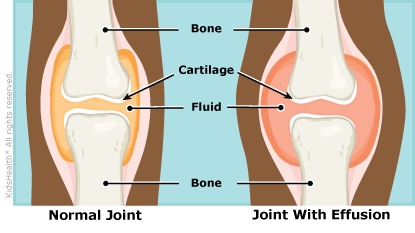Joint Effusion: How to Care for Your Child
A joint effusion happens when fluid builds up in a joint. The joint may hurt or feel stiff. In some kids, the joint also may look red or swollen.
Follow these care instructions to help your child's joint effusion heal.


-
Your child should take it easy and stop any activities that make the joint hurt.
-
If your child has pain and your health care provider says it's OK, you can give Ibuprofen (Advil®, Motrin®, or a store brand) or acetaminophen (Tylenol® or a store brand). Follow the package directions for how much to give and how often to give it.
-
If it is comforting, wrap a cold pack or ice in a towel and put it on the joint for about 15 minutes every few hours.
-
Follow the health care provider's instructions about:
-
when your child can return to usual activities
-
if your child needs a brace or an elastic bandage
-
if your child needs to use crutches

-
The pain or swelling gets worse.
-
The swelling doesn't go down in 1 week.
-
The swelling goes away and then comes back.
-
Your child gets a fever.
-
A different joint starts to hurt or swell.

-
The joint gets very red and/or painful.
-
There are red streaks on the skin near the joint.
-
Your child cannot move the joint.

What causes a joint effusion? A joint effusion can happen from:
-
an injury, such as a bump or a fall
-
stress on the joint over time (for example, from playing sports)
-
a joint infection
-
arthritis
What happens if the joint effusion doesn't get better? If your child follows your health care provider's recommendations and the joint effusion doesn't go away, more testing may be needed. Testing may include:
-
blood tests
-
taking some of the joint fluid out with a needle
-
testing on the joint fluid
-
imaging studies such as an X-ray, ultrasound, or MRI